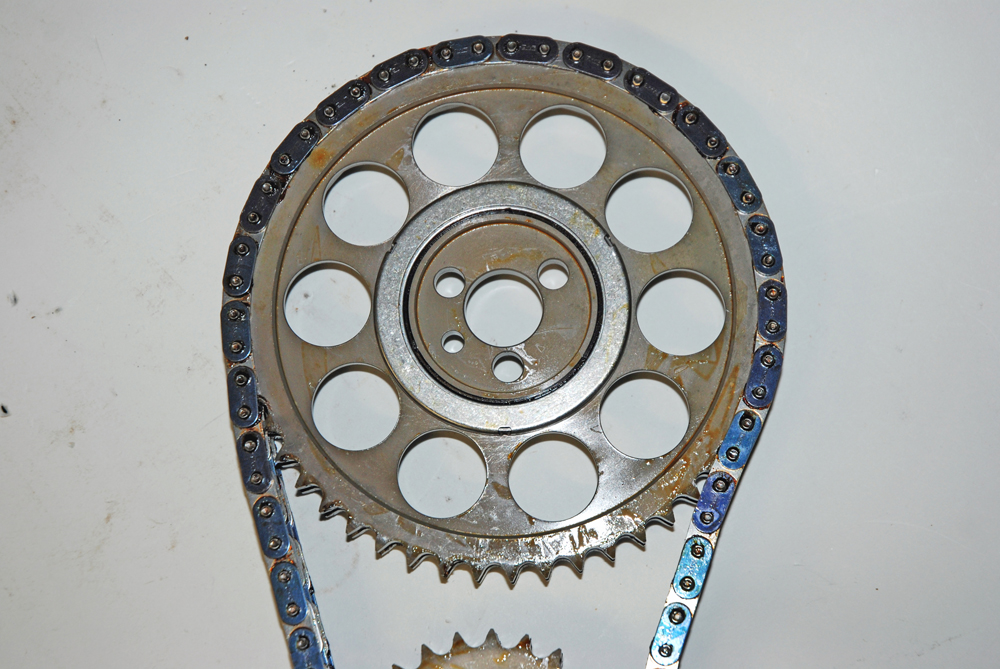
Today, timing chains don’t receive much attention. And in a racing engine, they’re pretty much one of the last things one tends to think about. They work and we forget about them. Besides, at first glance, the job of a timing chain doesn’t seem that big. All it does is turn the camshaft in conjunction with the crankshaft. But in plenty of applications (using a typical wet oil sump Chevrolet as a good example), the oil pump, mechanical fuel pump and even the distributor are indirectly driven off the chamshaft (and consequently driven by the timing chain). The last thing you need here is a weak link inside the system.
That’s not the end of it, either. The timing chain inside your engine also acts as a dampener. It absorbs a certain amount of crankshaft vibration and shock prior to transmitting it to the camshaft. Forces of this sort always seem to have a way of stressing a low performance stock or jobber chain. You also have to consider the components found further up inside the engine. As valve spring pressures increase, so does the level of harmonics and stress placed upon the chamshaft. Valve spring pressures also influence both the operation and the life of the cam drive. So what’s the solution? Check out the following:
Silent Timing Chains…
Years ago, it became clear to most racers that “silent” or link-belt timing chains weren’t exactly the hot high performance ticket. Typically, they’d wobble and stretch rapidly and many came factory-equipped with out-of-round sprockets. If you used one in your race engine, the only solution was to check the sprockets carefully before installation, then inspect the chain religiously. The only means to advance or retard the timing was with offset drive pin bushings (which in turn, required enlarged cam mount bolt holes to allow for movement) or with offset crankshaft keys. Equally important, the stock lower gears were of the press-molded or sintered iron variety. Needless to say, reliability at high RPM wasn’t a priority with these setups.
Some of the above is now ancient history. First large pin silent chains were introduced. These chains have larger-the-stock pins that actually roll as the chain and sprocket teeth contact. Gear teeth are heat treated, but as an added bonus, the lower crank gear is broached with a pair of additional key ways. This allows for 4-degrees of advance or retard in the camshaft. Finally, the use of a larger link belt system virtually eliminates the chordal action found in some roller timing chains (more on this below).
Roller Timing Chains…
A popular cam drive option is the roller timing chain. Like gear drive system, roller chains have been available for many years (decades, actually). For the most part, a roller chain is far more durable than a stock production line chain, but it is also heavier than a stock chain and sprocket assembly. The majority of high performance roller chain sets have provisions to advance or retard cam timing (usually multiple key ways broached into the crank gear). In addition, the actual gears are often produced from iron. This can constitute a problem with conventional iron blocks. Because of this, most engine builders machine either the backside of the cam gear or the block area surrounding the cam nose to accept a small Torrington bearing or a simple bushing. When the thrush bearing is added, then galling between the top gear and the block is eliminated.
Another issue that can occasionally enter the picture is the “chordal” action of a roller timing chain. What the heck is “chordal” action? This is the whipping motion that a roller timing chain experiences as it turns on the sprockets. Once the whipping begins, it can turn the chain into an “S” shape. This chordal action is difficult to control, and as you can well imagine, it can also have a profound effect upon valve timing, ignition timing and of course, the oil and fuel pumps. When the chordal action is allowed to go on for some time, it can result in a very tired and weak chain drive. Is there an answer for chordal action? Simple. Buy a quality chain set for your race engine and check it on a regular basis.
So what’s a racer to do? If you want “heavy duty” in a roller chain set, the Pro Series timing chain sets from Crane Cams are very tough to beat. These timing sets are based upon CNC-machined 4140 steel camshaft and crankshaft sprockets along with an extreme strength double-row roller timing chain (manufactured in Germany). The steel nitride hardened crankshaft sprocket has nine separate keyway locations, which make camshaft decreeing a snap – they allow for up to eight degrees of advance or retard. Bottom line here is, they’re filled with features. See the photos for more.
As you can see, there’s more to the good old fashioned timing chain than first meets the eye. Obviously, there’s a model for each and every budget. All have their advantages, and yes, all have certain disadvantages. Next issue, we’ll take a look at what might be the ultimate racing solution – the timing belt. Watch for it.







Leave a Reply